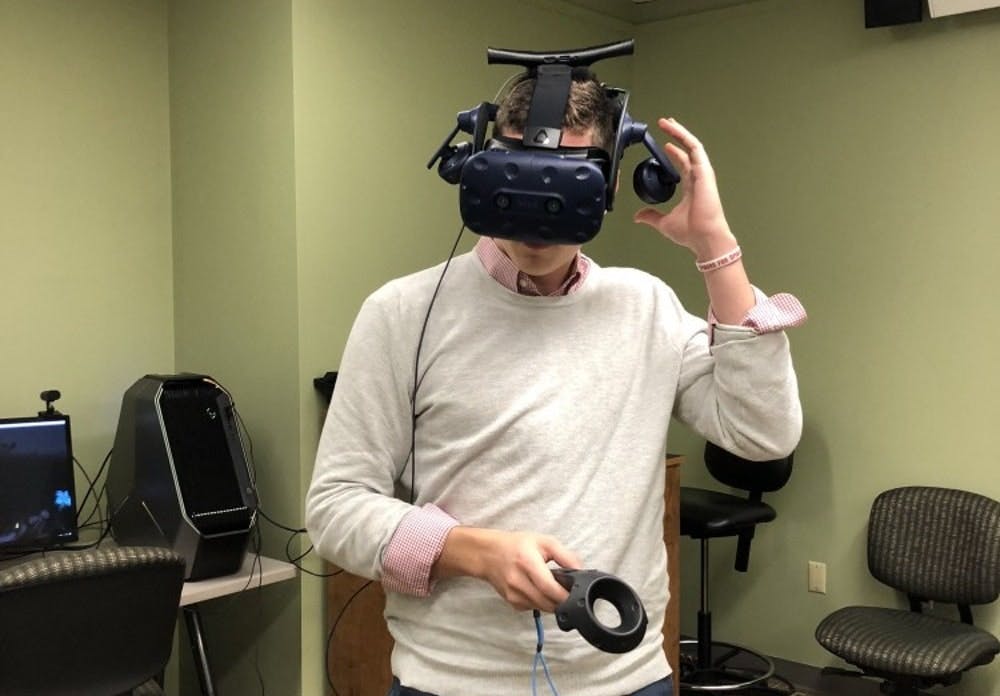The other day, I went to Tokyo, South Africa and New York all within minutes. This was all thanks to the addition of a virtual reality headset at the Technology Learning Center this semester.
Located in Boatwright Memorial Library, this new device will allow students to enjoy a unique experience. According to the center’s Instagram post to promote the headset, students will be able to “step inside games, reach out and interact with the virtual environment.”
After speaking with three members in the TLC, I was able to test this new piece of equipment. Once I had the headset on, I was transported to a virtual world where one could pull apart pieces of the human brain, draw a sketch for a 3D sculpture or simply take a tour on Google Earth through the streets of New York.
William Pflueger, TLC manager, said he was proud of the new headset, and that many students from various majors could use this resource. Pflueger said they had many different applications ranging from 3D painting, sculpture and modeling software, anatomy applications and more.
“If there’s an anatomy student who needs to study where all the bones are in the body, it gets you more involved,” Pflueger said.
There are virtual walls, so when you put on the headset you won’t walk into a desk or chair, Pflueger said. The headset goes on and two controllers are in your hands to help you use the tools on the screen, he added.
“The good thing with VR is that it’s pretty intuitive when you start using it,” Pflueger said. “It’s a steep learning curve in that you need to know the different buttons on the controller, but the skills are very transferable between the applications.”
The Center for Teaching, Learning and Technology, which is located down the hall from the TLC, has had its own separate headset for a couple of years already. Pflueger said the center's device had been mostly limited to specific classes and the headset in TLC had just been introduced this semester.
Many classes are scheduled to use the headset this semester, but Pflueger said they planned to open it to all students next semester. If students are unfamiliar with the headset, they can also make an appointment with one of the assistants at the TLC to have them walk them through the system, he said.
Once the headset was on, I was able to use the hand controllers and play around with various applications. For starters, the anatomy application I used allowed me to virtually pick apart pieces of the brain to really see the structure and names of all the parts, which could help students if they were studying for a science exam.
Junior Jay Do plans to use this device for his summer research project. He is a double major in business administration and art history, with concentrations in marketing and arts management. He currently works in the TLC and is interested in spending more time as well as his summer research money on this device.
“I plan to explore how we are progressing with technology,” Do said. “I plan to explore how our modes of experience change from a 2D to a 3D plane now and how artists plan on using that in the future.”
Enjoy what you're reading?
Signup for our newsletter
Do is currently in the process of drafting a research thesis plan, but there are no definite outlines yet. He agreed that this application can help people in certain majors.
“I definitely think that it should be focused on an art or science class,” Do said. “I do see it having a lot of capabilities in the future if people choose to work with it.”
One unique aspect about the sculpture application that Pflueger said could be useful for many students is its ability to transport creations made from the headset to a computer.
“You can save it and then export it to view it on a normal Mac desktop or windows PC,” Pflueger said. “The cool thing about that is you can then maybe do a 3D print of it.”
The TLC had five classes scheduled in one week to learn about the headset, so many professors are incorporating it into their curriculums, said Melissa Foster, the manager of TLC.
“You’re interacting, so it’s not passive,” Foster said. “Artwork and creating 3D sculptures that you pull into a virtual world also changes perspectives of the medium.”
The TLC has many different opportunities to use the new device, and so far it has proven very resourceful for many classes across various departments
Senior Grant Hinman, who works at the TLC as well, has used the virtual reality headset multiple times.
“I like VR because it is fully immersive and offers an experience unlike any other technology,” Hinman said in an email. “VR allows for a new (virtual) hands-on interaction with anything from molecules to world travel.”
Contact news writer Sophie Pilkington at sophie.pilkington@richmond.edu.
Support independent student media
You can make a tax-deductible donation by clicking the button below, which takes you to our secure PayPal account. The page is set up to receive contributions in whatever amount you designate. We look forward to using the money we raise to further our mission of providing honest and accurate information to students, faculty, staff, alumni and others in the general public.
Donate Now



